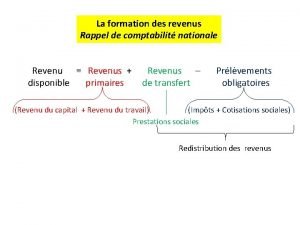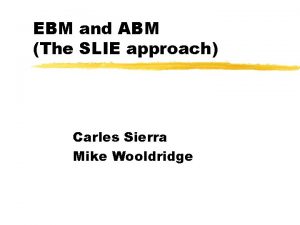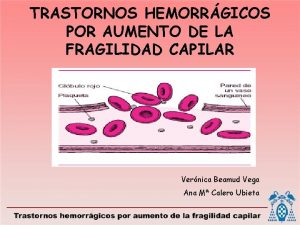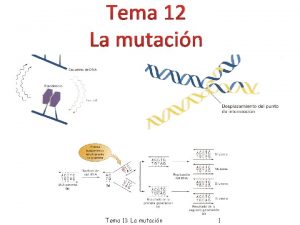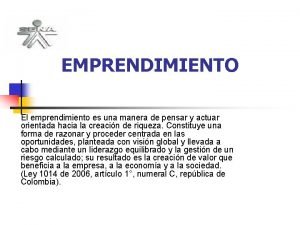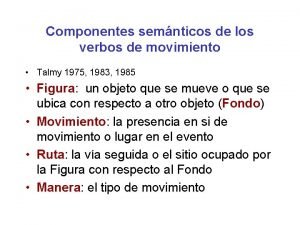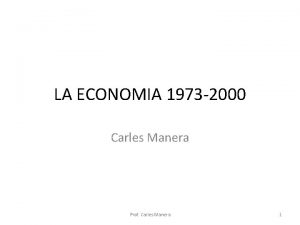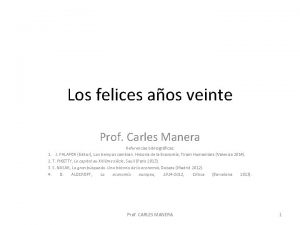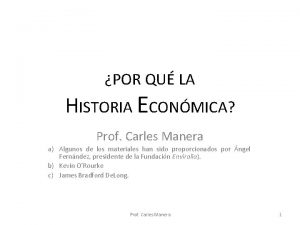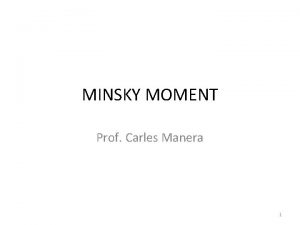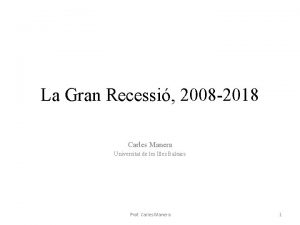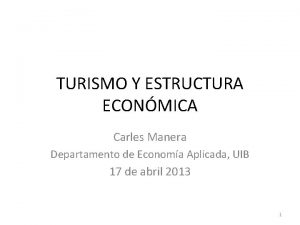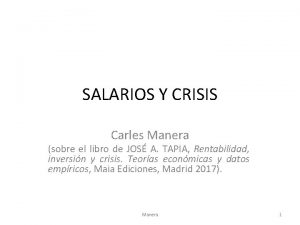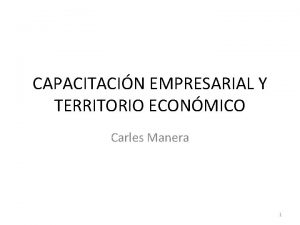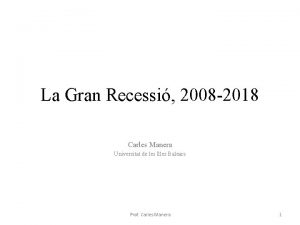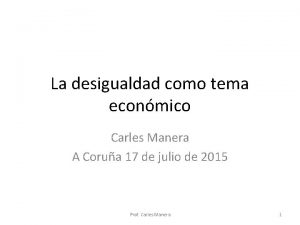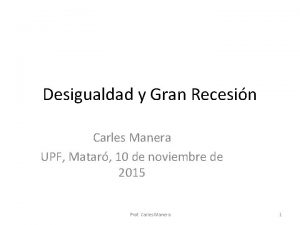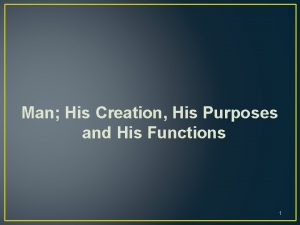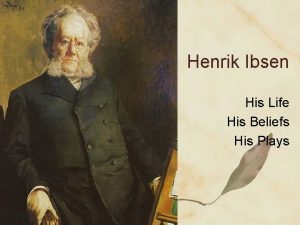On Piketty and his model Prof Carles Manera


























- Slides: 26

On Piketty and his model Prof. Carles Manera Prof. CARLES MANERA 1

PIKETTY’S WORK • Study of the historical evolution of the distribution of income and wealth from the 18 th century in over 20 countries. • Research spanning 15 years, with a team of over 30 investigators. • The book is divided into four parts: Income and Capital; The Dynamics of the Capital/Income Ratio; The Structure of Inequality; and Regulating Capital in the 21 st Century. • All the graphs in the work can be found on the following site: http: //piketty. pse. ens. fr/capital 21 c Prof. Carles Manera 2

BASIC PILLARS • 1. The importance of a patrimonial society in Europe and Japan. The capital/income ratios return to high levels in countries with weak growth. • 2. The concentration of wealth: based on (r) as the rate of return on capital; (g) the growth rate, the difference between (r) and (g) is increasing in the 21 st century, and returning to 19 th-century levels. • 3. Inequality in America, stimulated by huge wage differences more than wealth inequality (and even a combination of the two). Prof. Carles Manera 3

The notion of capital • 1. Link of capital K to return B, which goes to the capitalists. • 2. Capital stock includes all forms of assets: dwellings, lands, machinery, financial capital, people (in times of slavery). • 3. The income from capital includes, dividends, rent, interests. Prof. CARLES MANERA 4

BASIC RELATIONSHIPS α= SHARE OF CAPITAL INCOME IN NATIONAL INCOME r= RETURN ON CAPITAL β= PRODUCT CAPITAL / INCOME CAPITAL RATIO Prof. CARLES MANERA 5

Basic relationships I • 1. Share of income in the national income, expressed as: α α= B/Y Prof. CARLES MANERA 6

Basic relationships II • 2. Rate of return r, or profit on capital: r= B/K Prof. CARLES MANERA 7

Basic relationships III • 3. Product capital or income capital ratio, which he calls β: β= K/Y Prof. CARLES MANERA 8

First fundamental law of capitalism • THE SHARE OF INCOME DEPENDS ON THE PRODUCT β BY r: α= r · β Prof. CARLES MANERA 9

Second fundamental law of capitalism • THE RELATIONSHIP K/Y IS EQUAL TO THE SAVINGS RATE DIVIDED BY THE GROWTH RATE: β= s/g Prof. CARLES MANERA 10

Explanation § A country that saves a lot and grows slowly accumulates an enormous stock of capital relative to its income. § If K/Y increases, it means that the owners control a larger part of the resources. This is what has happened over the last 40 year. The factors that would explain the increase in the relationship β are a high savings rate, slow growth, privatisations, increase in share prices and real estate assets. Prof. CARLES MANERA 11

1 IMPORTANCE OF THE PATRIMONIAL SOCIETY. RETURN ON CAPITAL GREATER THAN ECONOMIC GROWTH… • The return on capital (r), in percentage terms, is higher than the percentage of economic growth (g). • This has economic consequences of social transcendence: the gap between rich and poor has widened. • Capitalists obtain an increasingly large part of the wealth to be distributed and bequeath it to their successors: the latter are born rich, and must make the capital continue growing above the returns for other individuals. Prof. Carles Manera 12

r > g r= rate of return on capital g= economic growth rate Prof. Carles Manera 13

RETURN (r) AND ECONOMIC GROWTH (g), 1700 -2100 Prof. Carles Manera 14

…WHICH CAUSES SOCIAL CONTRADICTIONS • The increase in inequality produced by the imbalance between (r) and (g) translates into the core problem of capitalism: instability is generated. • The mass of poor workers may rebel against the rich minority, by democratic or revolutionary means, which could put an end to the system. • THIS IS THE MAIN CONTRADICTION FOR PIKETTY. Prof. Carles Manera 15

THE IMPORTANCE OF THE PATRIMONIAL SOCIETY • PATRIMONY: all that is owned or can be sold on the market (without debts)= k. Actually, in Europe and Japan a rise was recorded in the ratio B= k/Y, over the last few decades: 200 -300% in 1950 -1960; 500 -600% in 2000 -2010. On average patrimony represented 2 or 3 years of income in around 19501960; and 5 -6 years in 2000 -2010. If, for example, we suppose that B= 600% and Y= € 30, 000 per capita, then k= € 180, 000�per capita. THIS LEVEL APPROACHES B=600 -700% OF THE SOCIETIES OF THE 18 th AND 19 th CENTURIES. Prof. Carles Manera 16

THE FALL OF CAPITAL • The fall of capital throughout the 20 th century was due to the Great Depression and the world wars. From the 1950 s on, and above all from the 1990 s, the ratio between capital and the GNP grows again in the eight richest countries. • Conclusion 1: capitalists obtain a return (r) that is greater than the growth rate of the economy. • This makes their wealth larger and so they transfer it to their successors in inheritances. • The natural tendency is for the ration between capital and growth to increase. The only exception occurred in the first half of the 20 th century. • Conclusion 2: inequality. Prof. Carles Manera 17

INCOME INEQUALITY IN THE UNITED STATES, 1910 -2010… Prof. Carles Manera 18

…AND ITS COMPARISON TO EUROPE Prof. Carles Manera 19

DIRECT TAXATION EXPLAINS SOCIAL DIFFERENCES… Prof. Carles Manera 20

…AS DOES TAXATION OF ASSETS Prof. Carles Manera 21

2 THE CONCENTRATION OF WEALTH The concentration of capital was extremely high in the 18 th and 19 th centuries, up until World War One : u Around 90% of total capital total controlled by the richest 10%; u Around 60% of total capital total controlled by the richest 1%. CLASSIC PATRIMONIAL SOCIETY: a minority lives from its wealth and the rest of the population works. Today, the concentration of capital is more intense, but less extreme than a century ago: u Around 60 -70% of total capital total controlled by the richest 10%; u Around 20 -30% of total capital total controlled by the richest 1%. u Around 40% control 20 -30% of total capital. RISE OF A PATRIMONIAL MIDDLE CLASS. Prof. Carles Manera 22

3 INEQUALITY IN AMERICA • There is not the same structure as in Europe. A more egalitarian model in certain aspects; and inegalitarian in others. • The capital accumulated in the past counts for quite a lot less than in Europe. Constant demographic growth reduces the level of inherited wealth and the concentration of. In the 19 th century, part of the society were clearly slavers. • Northern states: more egalitarian in Europe. Southern states: more inegalitarian. • The distribution of income is more unequal than in Europe in the 20 th century. Currently, it is more unequal than in the Belle Époque. Prof. Carles Manera 23

THE COMPOSITION OF CAPITAL, EUROPE-AMERICA Prof. Carles Manera 24

PIKETTY’S GENERAL CONCLUSIONS (1) 1. The history of the distribution of wealth is political, chaotic and unpredictable. 2. EQUILIBRIUM STATE. Whilst, for Karl Marx, when growth is zero (g=0), the contribution of capital increases (B=s/g) and the return rate is zero (r=0), we are faced with the possibility of wars and revolutions, Piketty’s vision is “less apocalyptic” (sic). Weak growth leads to an equilibrium state in B. • 3. This equilibrium state may however lead to an extreme concentration of capital, due to the fact that the result of r-g will be very high. • 4. This has no relation whatsoever to “imperfections of the market”. On the contrary, for the capital market the situation is perfect, because the r-g result increases. • 5. Ideal solution: progressive tax on capital on a global level, on the basis of automatic exchange of banking information. (This idea is also defended by Gabriel Zucman, a collaborator of Piketty’s, in a recent book, La riqueza oculta de las naciones, [The hidden wealth of nations], Pasado&Presente, Barcelona 2014, in which he also advocates the establishing of an international financial cadastre). • • Prof. Carles Manera 25

PIKETTY’S GENERAL CONCLUSIONS (2) • 6. The acceleration of the distancing process of the 1% from the whole of society over recent decades is confirmed. • 7. Natural evolution of the system towards inequality with no regulation mechanism. • 8. If we do not combat this inequality, we may reach a situation of selfdestruction of the system, which includes, in turn, the destruction of democracy. COMMENTS: a) The accumulation of wealth by a minority is due to: 1. Breakaway change with the arrival of ICT; 2. Creation of global communication, without frontiers; 3. Need for constant innovations with ICT. This has promoted a technological leap of the first order, which has enriched many in a short time and brought about cultural, economic and social changes in millions of people. All progress sustained by technological advances grow significantly and at the same time face new competitors. b) Conclusion 8 refers to Karl Marx’s theory, in his prediction that inequality and class struggle would bring about the collapse of capitalism, an unbridled capitalism that spreads inequality which destroys the system itself. c) Conclusion 5 does not manage to explain how to bring about this huge fiscal correction. We can infer that the nonassumption of the tax by THE WHOLE WORLD would make for capital movements stimulated by the countries that wish to recruit them, with the promise of never imposing the tax. Prof. Carles Manera 26
 Courbe de laffer
Courbe de laffer La patria poema bonaventura carles aribau
La patria poema bonaventura carles aribau Carles riba sunion
Carles riba sunion Language tool
Language tool Carles besses raebel
Carles besses raebel Ptria
Ptria Martin fell off his skateboard and badly bruised his elbow
Martin fell off his skateboard and badly bruised his elbow Lady macbeth act 1 scene 5 analysis
Lady macbeth act 1 scene 5 analysis Mi nombre la casa en mango street
Mi nombre la casa en mango street Onomatopoeia in caged bird
Onomatopoeia in caged bird Ordena esta rutina de una manera lógica.
Ordena esta rutina de una manera lógica. ¿qué porcentaje de 480 es 24?
¿qué porcentaje de 480 es 24? Llena la tabla adjunta de la siguiente manera
Llena la tabla adjunta de la siguiente manera Tres espiritus inmundos a manera de ranas
Tres espiritus inmundos a manera de ranas En cuanto a nuestra pasada manera de vivir
En cuanto a nuestra pasada manera de vivir A mi manera significato
A mi manera significato Manera
Manera Nucleofilos
Nucleofilos Hoy aprenderemos a repartir de manera equitativa cantidades
Hoy aprenderemos a repartir de manera equitativa cantidades Manera literal
Manera literal Me enfermaba con frecuencia. 8. íbamos a la playa.
Me enfermaba con frecuencia. 8. íbamos a la playa. A mi manera significado
A mi manera significado Extranjerismo
Extranjerismo Es la manera de pensar y actuar frente al emprendimiento
Es la manera de pensar y actuar frente al emprendimiento Dejar el hombre viejo y revestirse del hombre nuevo
Dejar el hombre viejo y revestirse del hombre nuevo Sumas con tabla posicional
Sumas con tabla posicional Indica manera
Indica manera
